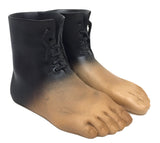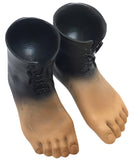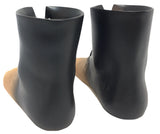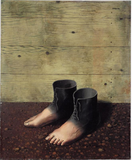Resin Figurine - Magritte Boot Feet Red Model Surrealism Statue 3 in L x 2 in W
PN# MAG02The Red Model / Le Modele rouge was a Surrealist painting completed by Rene Magritte (1935, oil on canvas 60 x 45 cm, Centre Pompidou Paris). This clever artwork is an adaptation of the painting into a statue for your table or bookshelf. It shows a pair of feet becoming boots with shoelaces. The combination of human feet with clothing is a physical impossibility, only possible in a dream. Surrealism was a 20th century art movement which mixed improbably dreamlike images as a way to challenge a viewer's understanding of the natural world.
Magritte painted a couple versions of this painting. This version was completed in November 1935 and is now in the collection of the Centre Pompidou in Paris. It is the one executed with the most scrupulous care rendering the tactile qualities of flesh and leather.
Some ask if these can be worn -- but sadly no, they are small figurines to put on your bookshelf.
Feet with Boots Red Model Collectible Figurine details:
- NOTE: this figurine is two pieces -- a left and right foot. You can position them however you want.
- Part of the Parastone Mouseion 3D Museum Collection of collectible figurines PN MAG02.
- Made from resin with hand painted details.
- Included color card with image of the original painting and a description of the artist.
- Measures: 2 in H x 3 in L x 1 1/8 in W per piece. So together both pieces measure 2 1/4 in W. Weight 0.4 lbs.
Rene Magritte (1898-1967) was born in Lessines near Tournai in French speaking Belgium in 1898. He spent his childhood in Chatelet and Charleroi. He attended the Academie des Beaux-Arts in Brussels from 1916 to 1918. There he met the brothers Victor and Pierre Bourgeois and the painter Pierre-Louis Flouquet. In 1919 Magritte contributed to the first issue of the review Au Volant published by the Bourgeois brothers. After a year of military service he worked as a designer, first of all for a wallpaper manufacturer in Brussels and then as a freelance designer of posters, publicity materials and exhibition stands. He painted his first acclaimed Surrealist painting, The Last Jockey, in 1926 and in the same year, along with the other Belgian surrealists, signed the declamatory leaflets Two Disgraces and the Married Couple of the Eiffel Tower. Between 1927 and 1930 Magritte lived in Le Perreux-sur-Marne near Paris, during which time he became acquainted with Hans Arp, Andre Breton, Salvador Dali, Paul Eluard and Joan Miro. Magritte's provocative essay Words and Pictures was published in the last issue of La Revolution Surrealiste in 1929, a year after he painted The Empty Mask.













